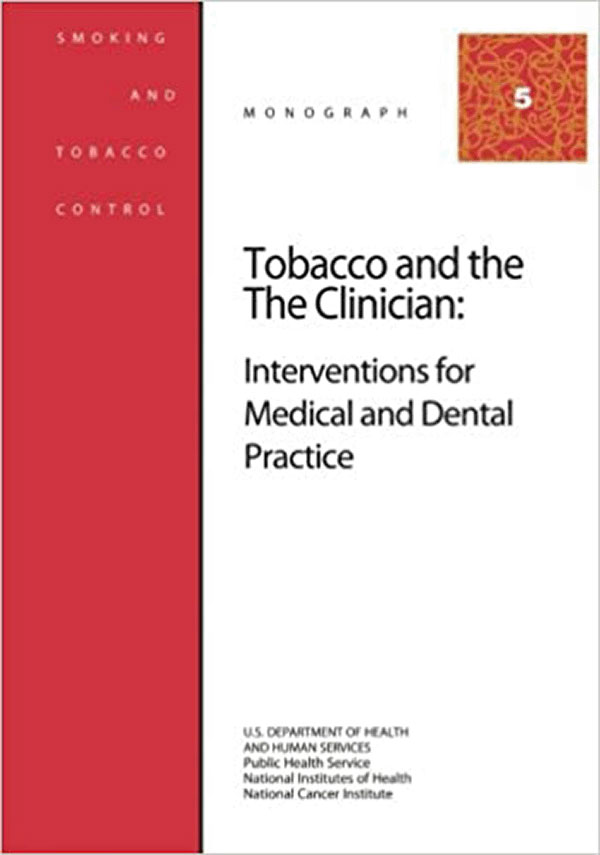
Office-based smoking cessation assistance is a useful tobacco control intervention strategy. Monograph 5 presents what interventions work, how to recruit and motivate clinicians to provide advice, and how to deliver smoking cessation assistance within the health care system.
On This Page
Suggested Citation
National Cancer Institute. Tobacco and the Clinician: Interventions for Medical and Dental Practice. Tobacco Control Monograph No. 5. Bethesda, MD: U.S. Department of Health and Human Services, National Institutes of Health, National Cancer Institute. NIH Pub. No. 94-3693, January 1994.
View Individual Chapters
Chapters and key topics covered within each chapter are listed below. Chapters generally include an introductory section, details on methodology, a chapter summary, research needs, and a reference list.
- Foreword (PDF, 502 KB)
- Preface (PDF, 68 KB)
- Acknowledgments (PDF, 51 KB)
- Chapter 1. Strategies for Office-Based Smoking Cessation Assistance (PDF, 374 KB)
- Overview of Office-Based Smoking Cessation Assistance
- Trends in Physicians’ Smoking Behavior and Patterns of Advice to Quit
- The Health Professional's Responsibility in Smoking Cessation: Strategies for Office and Community
- Chapter 2. Recruitment and Training of Practicing Physicians, Dentists, and Their Office Staffs (PDF, 383 KB)
- Effects of Training Family Physicians in a Comprehensive Smoking Cessation Intervention
- Doctors Helping Smokers: Development of a Clinic-Based Smoking Intervention System
- Prompting Smoking Cessation in Family Practice
- Smoking Cessation in Primary Care Practice: Summary of Results From the Quit for Life Project
- Physician and Dentist Interventions For Smoking Cessation
- The Tobacco Reduction and Cancer Control (TRACC) Program: Team Approaches to Counseling in Medical and Dental Settings
- Chapter 3. Training of Physicians in Training (PDF, 357 KB)
- Interventions for Smoking Prevention and Cessation
- Effects of Two Realistic Interventions To Teach Smoking Cessation
- Counseling to Primary Care Residents: A Randomized Trial
- Chapter 4. Special Practice Settings (PDF, 315 KB)
- Pediatricians’ Role in Smoking Prevention and Cessation
- Smoking Intervention by Providers of Health Care for Women
- A Physician- and Dentist-Delivered Smoking Cessation Intervention for Head and Neck Cancer Patients
- Medical Advice as a Communication About Risks of Smoking and Benefits of Quitting
- Chapter 5. Dissemination, Facilitation, and Maintenance of Office-Based Cessation Assistance (PDF, 238 KB)
- Smoking Cessation as a Clinic Quality Improvement Project
- Computerized Reminder System To Aid Physicians in Assessment and Counseling of Patients Who Smoke
- Physicians’ and Dentists’ Roles in COMMIT-The Community Intervention Trial for Smoking Cessation
- Dissemination of Physician-Based Smoking Cessation Interventions
- Clinical Interventions in Tobacco Control: A National Cancer Institute Training Program For Health Care Providers

